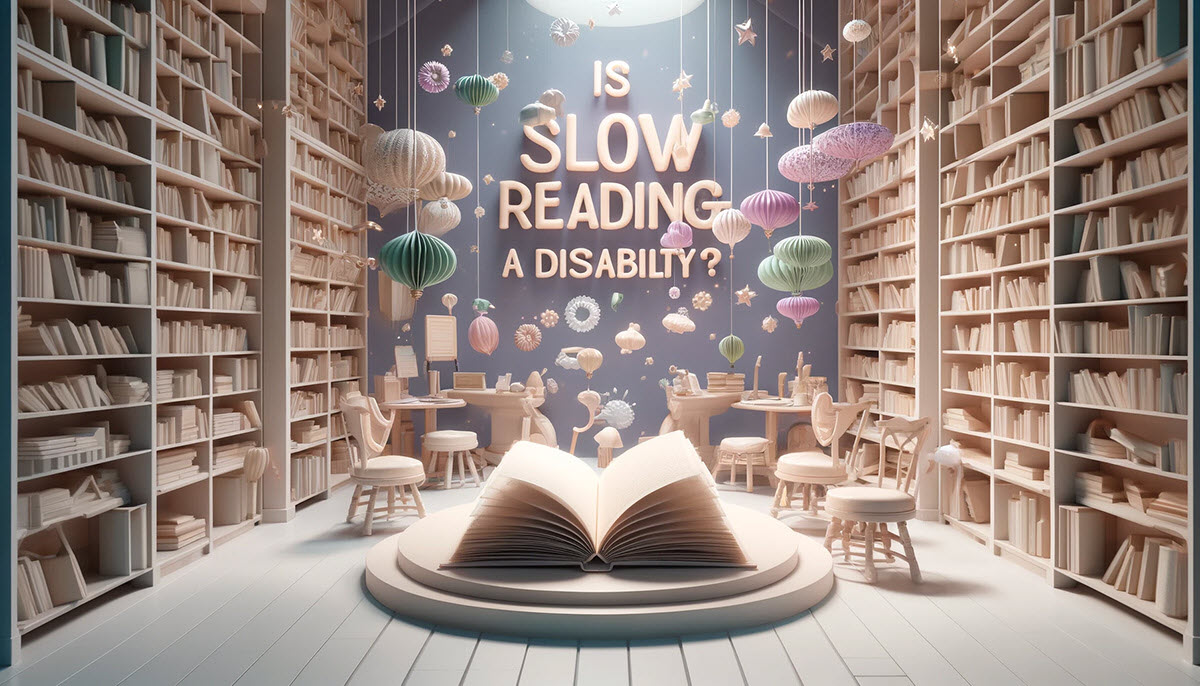Is Slow Reading a Disability? Insights on Reading Disabilities, Disorders, and Dyslexia
For parents, observing your child’s progression in reading is often a mix of immense pride and potential worry.
Noticing that your child reads slower than their peers may prompt concerns about underlying issues.
In this article, we dive into the complexities surrounding dyslexia, reading disabilities, and other reading disorders. It’s essential to differentiate between a child who simply reads at a slower pace and one who may have a genuine reading disorder.
We’ll discuss what professionals classify as a reading disability, how dyslexia is diagnosed and managed, and the broader implications of reading challenges.
Our goal is to provide clarity and supportive insights, helping you navigate and understand these important issues that affect numerous individuals across various age groups.

Understanding Slow Reading Speed
Many people question whether slow reading is inherently indicative of a disability.
This curiosity warrants a deeper exploration into the nature of reading speeds and their implications. It is important to recognize that reading speed varies widely among individuals.
While slow reading does not automatically suggest a disability like dyslexia, the context and consistency with which someone reads are crucial elements to consider.
Understanding the nuances of slow reading involves examining the various factors that can influence reading pace. These factors include the reader’s familiarity with the text, their linguistic and cognitive development, environmental influences, and even their emotional state at the time of reading.
For instance, a child might read more slowly if the material is challenging or unfamiliar, or if they are distracted or under stress.
Furthermore, assessing the consistency of slow reading is key. If slow reading is persistent and consistently accompanied by difficulties in comprehension or decoding words, it could point to a deeper issue that might require further evaluation.
However, if the slow reading occurs sporadically and can be attributed to external or temporary factors, it may not be a cause for concern.
By understanding these distinctions, we can better identify when slow reading is simply a variation in normal learning patterns and when it might be symptomatic of a more significant underlying condition. For practical tips on supporting children who are facing such challenges, read our guide on how to assist a child struggling with reading.
This insight is essential for providing appropriate support and interventions, ensuring that each individual’s reading and learning needs are adequately met.
Differentiating Slow Readers from Reading Disabilities
It’s critical to clearly distinguish between slow reading and reading disabilities such as dyslexia.
Slow reading typically involves taking more time to process text, which does not necessarily point to a disability. On the other hand, dyslexia is characterized by specific challenges that impact reading abilities significantly.
These challenges include difficulty with phonemic awareness, problems decoding words, and often a notable discrepancy between the individual’s reading skills and other cognitive abilities.
Experts suggest that persistent difficulties in areas such as reading fluency, comprehension, and retention may indicate a reading disability.
When differentiating between slow reading and genuine reading disorders or disabilities, it’s essential to ensure that distinctions are accurately made. This careful differentiation allows for the implementation of appropriate, tailored support that addresses the specific needs of each child.
Understanding and identifying a true reading disability is the first step towards initiating the right interventions and support systems. These interventions are crucial as they help to enhance not only the reading skills of the affected individuals but also their overall academic confidence and success.
This awareness and precise understanding help ensure that every child receives the support they need to thrive academically.
Potential Causes of Slow Reading and Dyslexia
Slow reading can arise from a variety of factors, each contributing to the pace at which a child processes text:
- Lack of practice: Similar to other skills, insufficient practice can result in slower reading speeds. Regular reading helps in developing fluency and quick recognition of words.
- Limited vocabulary: A smaller vocabulary can cause children to read more slowly, as they often need to pause to decode or comprehend new words, impacting their overall reading flow.
- Phonemic awareness: Challenges in manipulating the sounds within words can significantly slow down reading progress.
- Visual tracking issues: Difficulties in smoothly tracking text across a page can disrupt reading speed and comprehension.
- External factors: Less engaging educational environments or ineffective teaching methods can also impede reading development.
Understanding these causes is crucial in addressing slow reading and dyslexia.
Clinical research highlights that factors such as neurological conditions, genetic predispositions, and early literacy experiences are integral in understanding dyslexia, which involves more than just slow reading. It’s a complex interplay of various elements that influence learning abilities.
By deepening our understanding of these factors, we can enhance support for individuals with dyslexia and improve educational strategies for all learners.
Impacts of Slow Reading and a Reading Comprehension Disorder
Slow reading and reading comprehension disorders can profoundly affect a child’s academic and personal life.
Beyond the classroom, these issues can undermine a child’s self-esteem and hinder their social interactions, often leading to frustration and a reluctance to engage in reading activities. This reluctance is sometimes misinterpreted as a lack of interest or effort, rather than recognized as a sign of deeper cognitive challenges.
Slow reading, while not a disability on its own, can often be a symptom of a more complex reading comprehension disorder. These disorders involve more than just slow processing of text; they reflect significant difficulties in understanding and integrating written information.
Such challenges are distinct from general reading difficulties as they imply a deeper level of cognitive impairment.
Recognizing the distinction between typical variations in reading speed and those that signal reading comprehension disorders is crucial. Proper understanding of these differences helps in providing the appropriate support and interventions.
Parents and teachers play a vital role in this, as their support and understanding are key in helping children navigate these challenges, enhancing their reading skills, and improving their overall academic performance and quality of life.
Supporting Slow Readers Through the Writing Process
Supporting slow readers, particularly throughout the writing process, is essential in enhancing their overall literacy. Integrating strategies that aid in the comprehension and use of written language can significantly improve their learning experiences.
Here are some tailored methods to support a slow reader:
- Regular Practice: Encourage daily reading habits to build fluency. Consistent exposure to text helps slow readers become more familiar with various words and reading rhythms, gradually increasing their speed and comprehension.
- Choose Appropriate Books: Select books that align with your child’s reading level and interests. This alignment boosts confidence and engagement, making reading a more enjoyable and less daunting task. A well-chosen book can be particularly empowering, allowing slow readers to feel successful and motivated.
- Phonics Training: Programs that emphasize phonics are crucial as they help improve decoding skills, enabling children to break down words into their constituent sounds. This skill is vital for readers who struggle with word recognition and can lead to significant improvements in reading fluency.
- Expressive Opportunities: Encouraging slow readers to express themselves through writing can bolster their confidence and improve their writing skills. Writing activities should be integrated regularly, allowing children to practice constructing sentences and expressing thoughts, which in turn supports their reading development.
- Professional Guidance: Sometimes, it’s beneficial to involve reading specialists or educational therapists who can offer tailored support. These professionals can provide assessments to better understand a child’s specific challenges and strengths, and develop personalized strategies that cater to their individual needs.
- Supportive Environment: It’s also important to focus on developing a supportive environment that fosters growth in both writing and reading. This environment should be nurturing and patient, recognizing that each reader may face unique challenges. Patience and tailored support from both educators and parents are key in helping slow readers overcome their difficulties.
Ultimately, strengthening reading and writing skills can empower slow readers, helping them to better navigate and succeed in their educational journeys.
By fostering a comprehensive support system, we can ensure that slow readers not only improve their literacy skills but also build confidence in their abilities to express and engage with the written word.
When to Seek Professional Help for Word Reading Challenges
It’s essential to monitor the progression of reading skills in children, particularly when slow reading is coupled with specific challenges.
If your child frequently makes errors in comprehension, struggles persistently with recognizing familiar words, or shows an avoidance of reading activities, these may be signs that professional help is needed.
Seeking an evaluation from a reading specialist or an educational therapist can be a crucial step.
Such assessments are designed to delve deep into the nature of the reading difficulties your child is experiencing. They can determine whether these challenges are due to a reading disability or other underlying issues. Importantly, these evaluations help to identify the most effective intervention strategies tailored specifically to your child’s needs.
By understanding the specific aspects of the disability, professionals can implement targeted supports that address both the symptoms and root causes of the reading challenges.
This proactive approach ensures that interventions are not only appropriate but also comprehensive, potentially transforming a child’s educational experience and leading to significant improvements in their reading skills. To better recognize early issues, delve into our article detailing five warning signs that a student may have a reading disability.
Conclusion: Supporting Readers and Writers
In conclusion, supporting readers and writers, regardless of their reading speed or the challenges they face, is vital.
While slow reading is not inherently a disability, it can be indicative of broader issues. It’s important to approach each individual’s needs with empathy and effective strategies.
Understanding the intricacies of reading disabilities and disorders, such as dyslexia, enables us to provide more targeted and supportive measures. This ensures all readers and writers have the necessary tools and resources to succeed, fostering an inclusive environment where everyone can thrive. As parents and educators, your proactive engagement, patience, and encouragement are crucial in making a significant difference in your child’s literacy journey.
Additional Resources for Enhancing Written Language Skills
If you’re looking to bolster your or your child’s written language skills, especially if challenges stem from a reading disability, numerous resources are available. These tools are designed to improve both the mechanical and creative aspects of writing, offering methods that range from tutorials and templates to interactive exercises.
They provide comprehensive support for writing, addressing various aspects of written language development. Whether the struggle is due to dyslexia or another reading disorder, leveraging these resources can lead to substantial improvements in writing capabilities.
Organizations like the International Dyslexia Association, Reading Rockets, and local educational therapists specializing in early reading skills are invaluable sources of information and support. By continuing to advocate for and provide tailored support, we can enhance the holistic development of writing and reading skills for all learners.

Natalie is a full-time blogger and former elementary school teacher who specializes in helping parents teach their kids to read. With a qualification in Early Childhood Education, over 7 years of experience in education, and a passion for literacy, Natalie provides practical tips, activities, and resources for parents looking to support their child’s learning-to-read journey. She is the proud mom of two young readers and loves sharing her knowledge and experience with other parents. Natalie enjoys spending time with her family, reading, and exploring the great outdoors when she’s not blogging.

